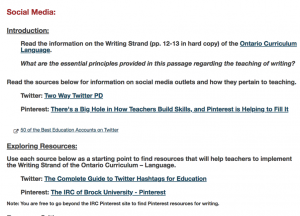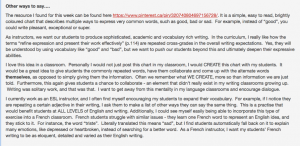Ruth Mcquirter Scott
Number of people involved:
30
Amount of time scheduled for activity:
Initial online portion + Forum post approx. 1.5 hours (follow-up in classroom 30 min; subsequent blog post approx. 3 hours)
Program/class:
Teacher Education program; Year 1 Language Arts course EDBE8P24 (Consecutive)
Procedure:
Steps 1 and 2 are done online via Sakai in an asynchronous format before the next class.
- Teacher candidates (TCs) begin by working through an online module introducing Twitter and Pinterest as sources of teaching resources and strategies. They also read the introductory portion of the Ontario Language Curriculum as it applies to the Writing strand. (see below; links in References)

- Each TC then locates an online resource for teaching writing to Junior/Intermediate grades, using Twitter or Pinterest as sources of information. They write a post on the Sakai Forum describing the resource, their reasons for selecting it, its connection to the Writing strand, and how they might use this resource in their own classroom. (see below for instructions – URLs are found in References)

Step 3 is done in face-to-face context in the class following the posts
- Prior to class, a Literacy Leader for each table group reads the posts of the table colleagues as well as 2 or 3 others in class, and looks for themes. The Literacy Leader then constructs some higher level questions based on themes or issues in the posts and leads a 20-30 minute discussion that includes time for each TC to describe their resource. The Instructor circulates to each table during the discussion time. By the end of the day each Literacy Leader uploads to Dropbox a report on key issues or topics of discussion from the group.
- During the next two weeks each TC builds on the initial resource by finding at least 2-3 other resources that support the aspect of writing selected. The TC creates a well-constructed blog post, following detailed criteria co-created by the class early in the term. It must conform to the conventions of educational blogs, with features such as live links, visuals, short paragraphs, sub-headings etc. The blog is posted to the TCs digital portfolio that was created during their 6-week technology course.
Example of activity:
Initial Forum posting by a Teacher Candidate (used with permission):

Portion of subsequent blog post, building on the initial Forum post:

Connections to the literature:
This activity is closely aligned with research on the role of teachers in New Literacies (Jacobs, 2014; Fisher & Rosenthal Tolisano, S., 2014; Ungerer, 2016) as curators of digital resources. It also reflects the importance of teachers developing personal learning networks (PLNs) as they strive to be Connected Educators (Nussbaum-Beach & Ritter Hall, 2012). Furthermore, the use of Professional Learning Conversations to discuss the resources helps to foster the development of collaborative relationships characteristic of Communities of Practice (Wenger, White, & Smith, 2009).
Ways in which the plan addresses democratization or justice:
In a broad sense, Connected Educators develop a greater global perspective as they interact online and form Personal Learning Networks. In the classroom context, the ubiquitous nature of online teaching resources enhances an educator’s ability to provide engaging, appropriate materials for students of diverse backgrounds, learning styles, and interests.
Variations:
This process is repeated 4 times during the course, once for each of the 4 strands of language. Other sources of online educational resources are highlighted for each strand including educational blogs (Media strand), teacher websites and ministry resource banks (Reading), visual and auditory sources such as podcasts, films, and curated photo collections (Oral Communication)
How to build the activity in Sakai:
Only a basic comfort level with Sakai is needed. The introductory module on social media as a source of online resources requires a clear series of steps and embedded links to websites. A Forum is needed for initial posts; Dropbox is used for Literacy Leaders reports. Teacher candidates already have a blog site as part of their digital portfolio.
Other technology needed:
None. Just access to Sakai (LMS)
References:
Cummings, M. (2015, April 2]. There’s a big hole in how teachers build skills,
and Pinterest is helping fill it [Web log post]. Retrieved from http://www.slate.com/blogs/schooled/2015/04/02/pinterest_and_teachers_how_the_site_is_filling_a_gap_in_teacher_training.html
Curtis, I. (2012, July 5). Two-way Twitter PD [ Web log post] Retrieved from
https://www.middleweb.com/1403/twitter-for-summer-pd/
Fisher, M. & Rosenthal Tolisano, S. (2014). Digital masters: Becoming a blogmaster,
annotater, or web curator. In H. . Jacobs (Ed.), Mastering digital literacy, pp.
5-26, Bloomington: IN: Solution tree Press.
IRC Brock University. https://www.pinterest.ca/ircbrock/
Jacobs, H. H. (Ed.) (2014). Leading the new literacies. Bloomington, IN: Solution
Tree Press.
Nussbaum-Beach, S. & Ritter Hall, L. (2012). The connected educator: Learning
and leading in a digital age. Bloomington, IN: Solution Tree Press.
Ontario Curriculum Grades 1-8 : Language.
http://www.edu.gov.on.ca/eng/curriculum/elementary/language18currb.
Teach Thought Staff (2018, July 9). The complete guide to Twitter hashtags for
education [Web log post]. Retrieved from https://www.teachthought.com/twitter-hashtags-for-teacher/
Teach Thought Staff (2017, September 25). 50 of the best education accounts on
Twitter [Web log post]. Retrieved from https://www.teachthought.com/technology/50-educator-twitter-accounts-worth-following/
Unger, L. (2016). Digital curation as a core competency in current learning and
literacy: A higher education perspective. International Review of Research in Open and Distributed Learning. 17(5), 1-27.
Wenger, E., White, N., & Smith, J. (2009). Digital habitats: Stewarding technology for
communities. Portland, OR: CP Square.

